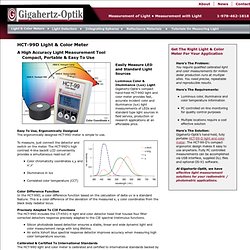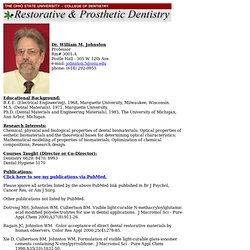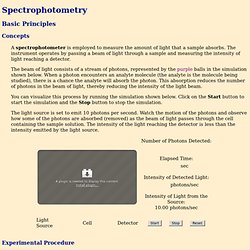

Color. Hand Held Light Meter - Luminous Color Meter For LEDs - HCT-99D Light Measurement Tool. Easily Measure LED and Standard Light Sources Luminous Color & Illuminance (Lux) LightGigahertz-Optik's compact hand-held HCT-99D light and color meter provides fast, accurate incident color and illuminance (lux) light measurements of LEDs and standard type light sources in field service, production or research applications at an affordable price.

Easy To Use, Ergonomically DesignedThe ergonomically designed HCT-99D meter is simple to use. To measure, just connect the detector and switch on the meter. The HCT-99D's high contrast 4-line backlit LCD conveniently provides a simultaneous read-out of: Color chromaticity coordinates x,y and u',v' Illuminance in lux Correlated color temperature (CCT) Color Difference FunctionIn the HCT-99D, a color difference function based on the calculation of delta uv is a standard feature. Silicon photodiode based detection ensures a stable, linear and wide dynamic light and color measurement range with long lifetime. Here's The Requirements: Color Hunter. Online Color Scheme Generator.
Color Scheme Designer 3. Color Blender. Optical Illusions and Visual Phenomena. Plant colors. Genetic and Biochemistry of Anthocyanin Biosysnthesis. Light waves. Laser is produced by a living cell. 13 June 2011Last updated at 01:42 By Jason Palmer Science and technology reporter, BBC News The single-cell lasers were less than 20 millionths of a metre across A single living cell has been coaxed into producing laser light, researchers report in Nature Photonics.

The technique starts by engineering a cell that can produce a light-emitting protein that was first obtained from glowing jellyfish. Flooding the resulting cells with weak blue light causes them to emit directed, green laser light. The work may have applications in improved microscope imaging and light-based therapies.
Laser light differs from normal light in that it is of a narrow band of colours, with the light waves all oscillating together in synchrony. Most modern forms use carefully engineered solid materials to produce lasers in everything from supermarket scanners to DVD players to industrial robots. The pair used green fluorescent protein (GFP) as the laser's "gain medium", where light amplification takes place. Welcome to Bruce Lindbloom's Web Site. EasyRGB - The inimitable RGB and COLOR search engine!
Stephen H. Westin. PMVS2. Introduction New!

Please refer to our new software Clustering Views for Multi-view Stereo (CMVS). CMVS contains PMVS2 and have additional useful features (e.g., no need to worry about memory limitation any more.) PMVS is a multi-view stereo software that takes a set of images and camera parameters, then reconstructs 3D structure of an object or a scene visible in the images. Only rigid structure is reconstructed, in other words, the software automatically ignores non-rigid objects such as pedestrians in front of a building. PMVS2 was developped when Yasutaka Furukawa was a graduate student at University of Illinois at Urbana-Champaign under the supervision of Prof. PMVS2 is used for real production purposes by Industrial Light & Magic, Weta Digital, and Google Inc. Download & Resources Changchang Wu distributes an automated GUI-based end-to-end 3D reconstruction system from images, which integrates our CMVS and PMVS.
CGAL - Computational Geometry Algorithms Library. Dr. Johnston's Bio. Educational Background: B.E.E.

(Electrical Engineering), 1968, Marquette University, Milwaukee, Wisconsin. M.S. (Dental Materials), 1971, Marquette University. Ph.D. (Dental Materials and Engineering Materials), 1983, The University of Michigan, Ann Arbor, Michigan. Research Interests: Chemical, physical and biological properties of dental biomaterials; Optical properties of esthetic biomaterials and the theoretical bases for determining optical characteristics; Mathematical modeling of properties of biomaterials; Optimization of chemical compositions; Research design.
Courses Taught (Director or Co-Director): Dentistry 6629; 8470; 8993 Dental Hygiene 3170 Publications: Click here to see my publications via PubMed. Please ignore all articles listed by the above PubMed link published in Br J Psychol, Cancer Res, or Am J Surg. Other publications not listed by PubMed: Dotrong MH, Johnston WM, Culbertson BM. Ragain JC, Johnston WM. Xie D, Culbertson BM, Johnston WM. Spectrophotometry: Basic Principles. Concepts A spectrophotometer is employed to measure the amount of light that a sample absorbs.

The instrument operates by passing a beam of light through a sample and measuring the intensity of light reaching a detector. The beam of light consists of a stream of photons, represented by the purple balls in the simulation shown below. When a photon encounters an analyte molecule (the analyte is the molecule being studied), there is a chance the analyte will absorb the photon. This absorption reduces the number of photons in the beam of light, thereby reducing the intensity of the light beam. You can visualize this process by running the simulation shown below. Roy Bern. Color Balancing Algorithms.